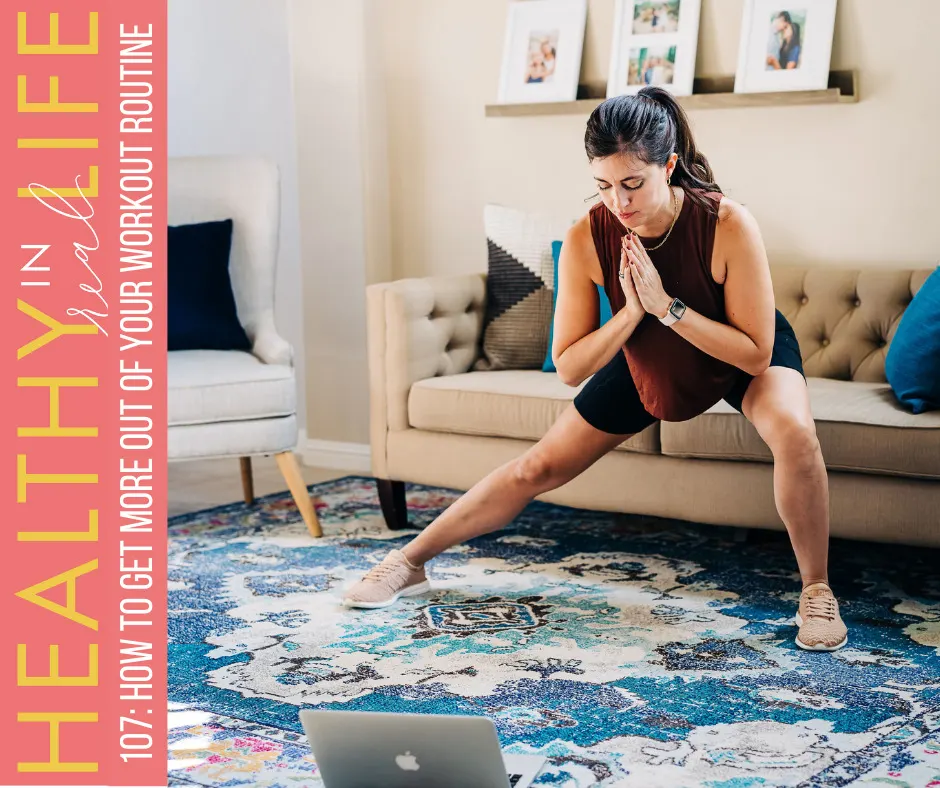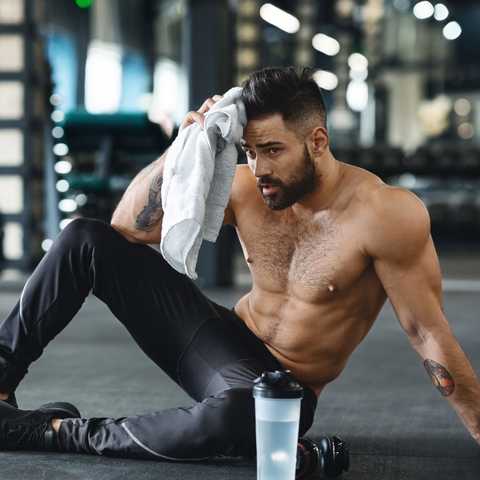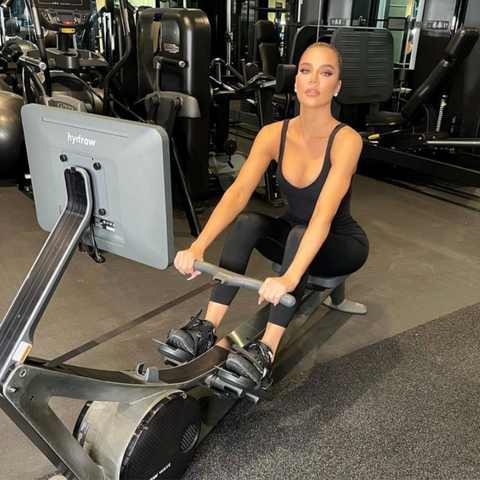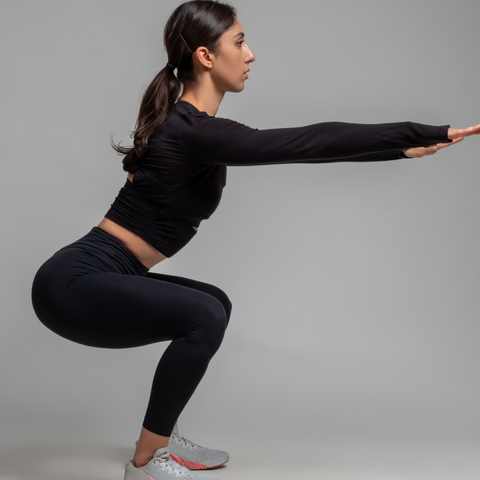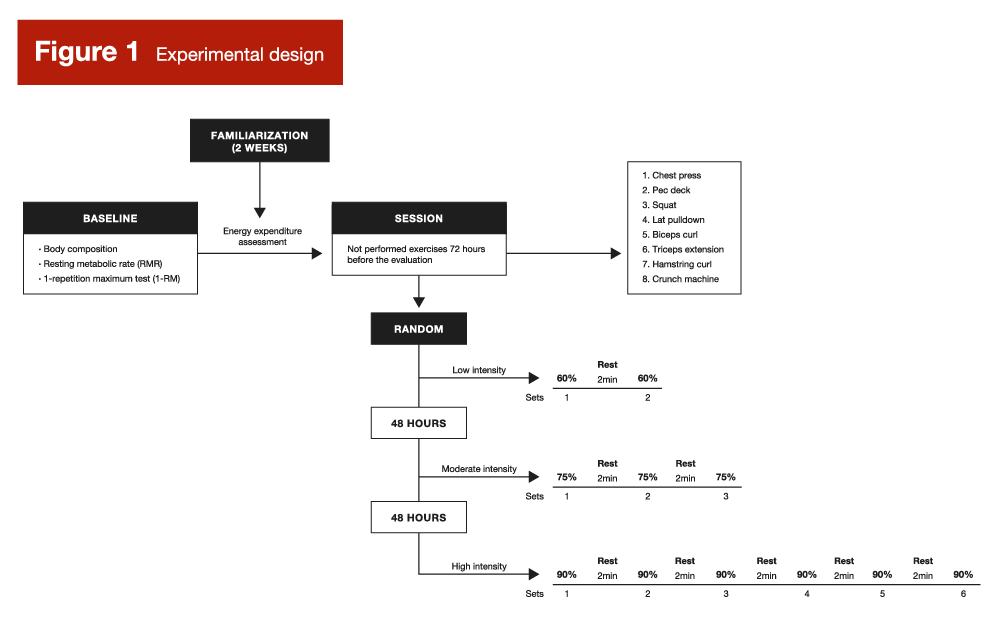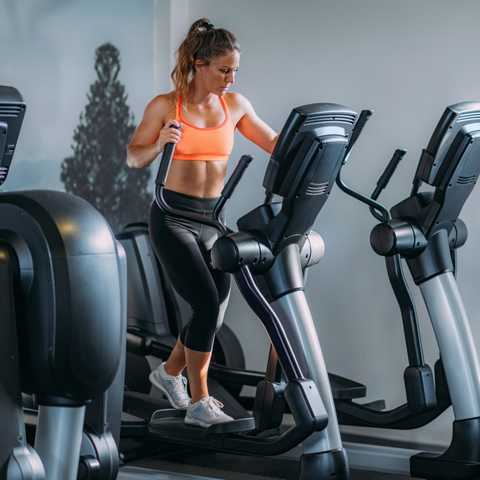Dubbed “wings” due to their ability to give the back a wide, wing-like shape when they’re well-developed, this muscle group, officially called the latissimus dorsi, is the largest and most powerful muscle not only in the back but the entire upper body.
Given its size, strength, and aesthetic appeal, it’s important to train the lats often and well. You can work your biceps until you’re blue in the face (don’t actually do that), but if you don’t have a well-built back, you will not have a muscular-looking physique.
So, how exactly should you be training the largest muscle of your upper body? Not to worry, because pun intended, I’ve got your back. We’re about to go over the best workouts, including a gym and home version, and exercises to help you train and grow your lats.
Table of Contents:
- Lat Muscles Anatomy & Function
- Why Is It Important To Train Your Lats?
- 2 Best Lat Workouts: Gym & Home Version
- Programming Tips For Lat Workouts
- How to Effectively Train Your Lats At Home
- Best Lats Exercises
- Benefits of Training Your Lats
- Tips to Help You Build Bigger Lats
- How To Continue Progressing Your Lat Training
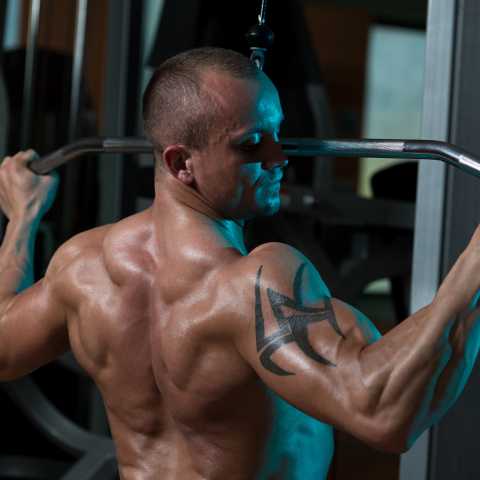
Lat Muscles Anatomy & Functions
The lat muscles are a pair of large, triangle-shaped muscles that sit on the lower two-thirds of your back, spanning from your spine all the way to the very outside of your back.
This makes them the largest muscle in the upper body and essential for upper-body strength. Their primary goal is to manipulate the shoulder, but they also work to flex and extend the spine laterally and provide stability. This back muscle also plays a role in scapula control and respiration.
Interestingly, even though the lats are huge, it’s still just one muscle that can be separated into 3 parts: the upper lats, middle lats, and lower lats. There are four different origin points for the lats, but all of the muscles eventually merge and insert into the intertubercular groove of the humerus.
When examining the lats functions, they do just about everything, including:
- Shoulder Adduction: Bringing the elbows down to the sides of your body, like when you perform a pull-up or lat pulldown.
- Shoulder Extension: Involves bringing the elbows down in front of your body during exercises such as chin-ups and underhand rows.
- Shoulder Horizontal Abduction: This involves bringing the elbows backward to your side, like during rowing.
In addition, the lats also provide stability to your spine, enable your spine to laterally extend and flex, and assist with breathing. Needless to say, the lats are extremely important.
Why Is It Important to Train The Lats?
As we just discussed, the lats are the largest and strongest muscles in the upper body. Their extensive size and many roles mean optimal back function requires strong and functioning lat muscles.
If you do not build muscle in your lats, you will not have a strong, healthy body, which will lead to potential injury and poor performance.
The Best Lat Workouts For The Gym And Home
I’ve created two separate lat workouts here, a gym version and an at-home version.
The home workout assumes you have a resistance band. If you don’t have one, check out this article on the best resistance bands and consider adding one to your home gym. If you have dumbbells at home, you can incorporate those as well.
Gym Lat Workout
You can incorporate both sessions into your weekly training schedule but make sure you leave 2-3 days in between each for proper recovery time. I’ll talk about this more in the exercise section, but it’s a good idea to switch up your grips routinely to ensure you’re hitting multiple lat angles.
Session 1:
|
Exercise |
Sets |
Reps |
|
Chin Ups |
4 |
8-9RPE |
|
T-Bar Row |
4 |
6-8 |
|
Lat Pulldowns |
3 |
8-12 |
|
Dumbbell Row to Hip |
3 |
8-12 |
|
Straight Arm Pulldown |
3 |
12-15 |
Session 2:
|
Exercise |
Sets |
Reps |
|
Pull Ups |
4 |
8-9RPE |
|
Bent Over Row |
4 |
6-8 |
|
Meadows Rows |
3 |
8-12 |
|
Lat Pull Ins |
3 |
8-12 |
|
Wide Grip Seated Row |
2 |
12-15 |
Best Home Lat Workout
Remember, at a minimum, you’ll need a resistance band to use in place of other equipment. At some point, I highly recommend investing in dumbbells, so you’re able to continue increasing your weights.
|
Exercise |
Sets |
Reps |
|
Standing Bent Over Row |
4 |
8-9RPE |
|
Seated Lat Pulldown |
4 |
8-9RPE |
|
Meadows Rows |
4 |
8-9RPE |
|
Lat Pull Ins |
4 |
8-9RPE |
|
Wide Grip Seated Row |
4 |
8-9RPE |
How to Effectively Train Your Lats At Home
In order to progress at home, you will need to use RPE and focus on bringing your sets close to failure each set. You will also need to pay close attention to a strong mind-muscle connection.
If you have the ability to perform chin-ups somehow, definitely do it, as it will help your progress infinitely. If not, I recommend starting your workout with long isometric squeezes to pre-fatigue your muscle. Squeeze your lats as hard as possible for 10-30 seconds before you perform an exercise.
Regardless of whether you’re at home, your main goal is to always progress. You can even use methods such as EMOM, which enables you to train high volume.
4 Programming Tips For Your Lat Workouts
Now that you have your workouts, I want to go over my favorite tips for getting the most out of these lat programs. After we discuss these, I’ll discuss the best lat exercises, so you know how to do each with correct form.
1) Focus On Your Mind-Muscle Connection:
Just about any pulling movement effectively trains your lats. However, most pulling movements work all of your back muscles, not just the lats, so if you’re trying to emphasize lat growth, focus on a mind-muscle connection. This helps guarantee that they are the muscle group doing the work.
To emphasize a mind-muscle connection, make sure you aren’t just going through the motions. Instead, really think about the lats and connect with them. For example, when you’re performing rows to hip, really concentrate on your lower lats as you row.
2) Train Twice A Week:
To best take advantage of the training and muscle-workout recovery cycle, I suggest training your lats twice a week, 2-3 days apart. This allows you to train with intensity and then builds in sufficient time for a full recovery.
This cycle is then repeated so your lats are either always being trained or recovering.
3) Train The Different Muscle Movements:
The lats are huge and responsible for any upper-body pulling motion. This includes vertical, horizontal, upward, downward, and any other direction you can think of. In order to optimize your lat training, I always recommend placing a load on it through each of these motions.
4) Train The Lats’ Different Muscle Parts:
Even though the lats are one big muscle, it’s a massive muscle. Because it’s so large, I always make sure to include exercises that train the upper, middle, and lower lats, almost as if they are separate muscles.
This ensures you’re hitting all of the angles of the lats, which is good news for muscle hypertrophy and growing your wings.

10 Best Lat Exercises to Build a Big Back
There is an endless assortment of awesome exercises for the latissimus dorsi, but some are much better than others. The best of the best are the ones I included in the workouts above, and we’re about to get into how to do each using proper form.
The gym versions utilize an assortment of equipment, but for your home version, you’ll use a resistance band or dumbbells for the majority of the movements.
1. Chin-Ups:
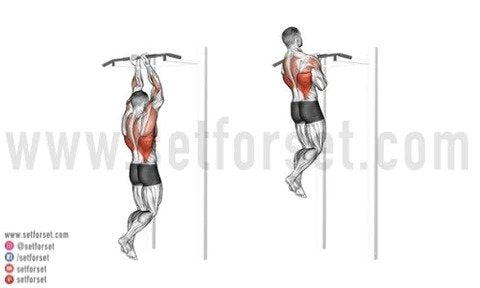
There should never be a debate about whether chin-ups or pull-ups are best. At SET FOR SET, we believe both are equally important!
Pull-ups are often touted as being the better of the two for lats training, but they both activate your muscles differently. In fact, the movement pattern during chin-ups is shoulder extension, which is completely different from pull-ups!
Remember, to optimize your lat training, you need to use every function, so make room for both in your routine. Interested in learning more about the differences between the two exercises? Check out our article on pull ups vs chin ups for additional information!
How to do Chin-Ups:
- Grab the bar with an underhand grip and shoulder-width grip, starting with arms straight.
- Pull your shoulder blades together.
- Contract your core tight and lean back slightly.
- Drive your elbows down to the ground until your head is over the bar. Utilize a complete range of motion to effectively work your lats.
2. Pull-Ups:
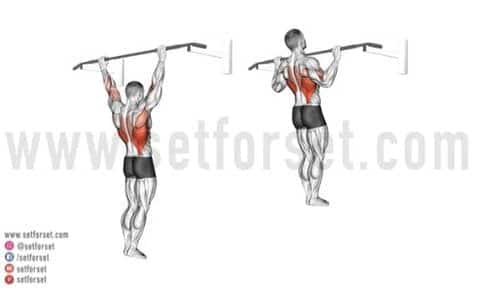
Pull-ups differ from chin-ups in that they use an overhand grip. As a result, your arms are pushed outward, so your elbows are out to your sides, performing shoulder abduction, rather than the shoulder extension that occurs with chin-ups.
Both motions hit the lat in a different manner, making both necessary for complete lat training. You can also perform wide-grip pull-ups as well by grabbing the bar a couple of inches wider than normal.
If you’re unable to do a complete pull-up, follow our pull-up progression plan, and you’ll be able to in no time!
How to do Pull Ups:
- Grab the bar with an overhand grip and hands slightly wider than shoulder-width apart.
- Pull your shoulder blades back and make your core muscles tight.
- Drive your elbows down and inward to your sides.
- Continue until your head is over the bar. Slowly lower down, and repeat.
3. Standing Bent Over Row:
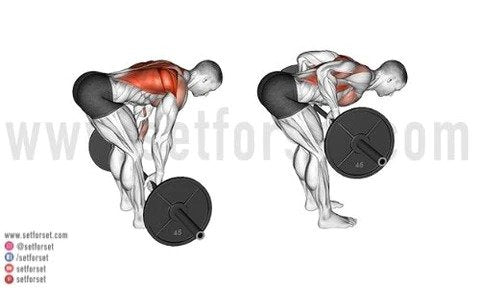
Standing barbell rows should make up the foundation of your training program. You can even switch up your barbell bent-over row grip, enabling you to target different parts of your lats using the same exercise and equipment.
This exercise is essential for building your lats due to the amount of stress you can place on them (the more you stress your muscles, the more growth you’re going to get). With that in mind, the bent-over row is vital for massive lats.
For the at-home version, place the resistance band under your feet to anchor it down. Grab one end of the band with each hand, and then follow the exact same rowing motion. If you have dumbbells, you can also do dumbbell rows instead.
How to do Standing Bent Over Rows:
- The barbell row is performed with a slightly wider than shoulder-width grip. For this version, use an overhand grip.
- Stand up with the barbell, then lean your torso forward slightly, keeping your knees back. Come forward until your arms hang freely in front of your knees.
- Keep your back tight and shoulder blades pulled back, tighten your core muscles, and drive your elbows up to the sky.
- Bring the bar to your chest, and then lower it in a controlled motion.
4. T-Bar Row:
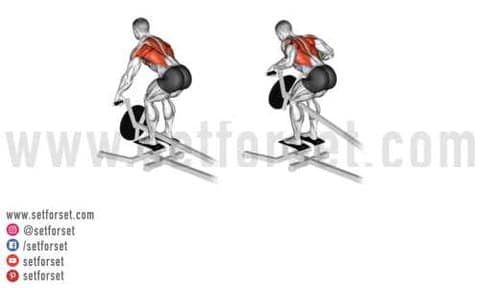
The T-Bar row is a cross between a machine and free weight as the bar helps support and guide the loads, ultimately allowing for heavier loads.
However, it’s different than most machines, because the weight can still sway, requiring your stabilizer muscles to significantly work.
How to do the T-Bar Row:
- Load the collar, and then stand on either side of the machine. Grab the bar with an overhand grip, stand up with the load, and then lean forward.
- Keep your core tight and your shoulders pulled back.
- Keep your elbows tucked at about a 45-degree angle and drive your elbows up to the sky.
- Bring the weight upward all the way to your chest, before slowly lowering it down.
5. Seated Lat Pulldowns:
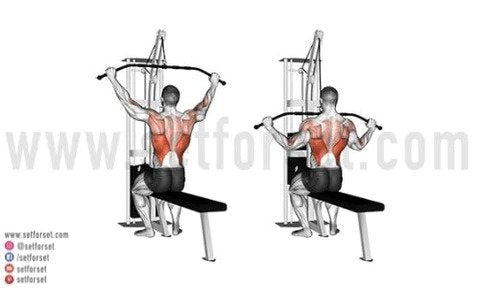
Lat pulldowns are similar to pull-ups but allow for greater lat isolation, which is ideal when lat growth is the goal. You can either use a lat pulldown machine or a cable machine for this exercise.
For the at-home version of this exercise, anchor your resistance band to something overhead. You could even add a hook to the top of your door frame, resting the middle of the band on the hook. Then sitting on the floor or a chair, you can pull down on each end of the resistance band, mimicking the same lat pull-down motion.
How to do Seated Lat Pulldowns:
- Adjust the seat so your knees fit snugly underneath, keeping your feet planted on the ground.
- Use an overhand grip that’s slightly wider than shoulder-width apart.
- Keeping your shoulder blades retracted, use your elbows to pull down, lowering the bar down until it reaches your upper chest.
- Return the bar to the starting position, and repeat.
6. Lat Pull-Ins:

Lat pull-ins are the long-lost brother of the lat pulldown. Instead of using a double grip and facing toward the resistance, use a single grip attachment and face sitting to the side.
You will then grab the handle and pull your elbow into your waist as you perform a mini side crunch. Trust me, it does a great job targeting your lower lats.
How to do Lat Pull-Ins:
- Set up a cable machine with a single attachment on a high setting.
- Sit so your legs and torso are facing perpendicular to the cable.
- Grab the handle with the inner arm.
- Pull the cable down and inward. Try to touch your hip with your elbow. Return the cable to the starting position, and repeat.
7. Dumbbell Row To Hips:
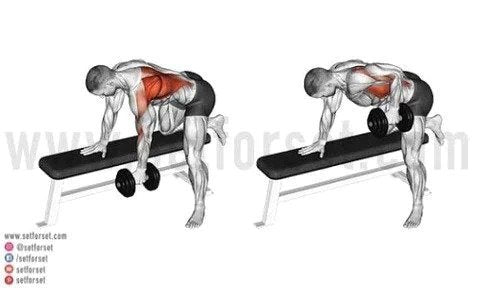
In general, dumbbell exercises are great for hitting your lats. And one of the best lat exercises around, the single-arm dumbbell row to hips is excellent for some movement variety, as it requires you to pull your weights to your hips, which is done by trying to pull the elbow to the hip in a sweeping motion.
This is another great movement for working your lower lats and as it’s a unilateral exercise, it’ll help identify any muscle imbalances that may exist.
How to do the Dumbbell Row to Hip:
- Grab a single dumbbell with a neutral grip.
- Place your other hand on a bench for support
- Step your leg of the dumbbell side back and lean your torso forward, so it’s almost parallel with the ground.
- Pull the dumbbell up by driving your elbow back to the hip in a sweeping motion. Lower down, and repeat.
8. Meadows Row:
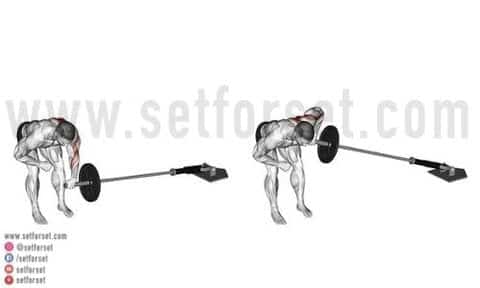
Named after the late John Meadows, the Meadows row is a landmine row variation, but instead of standing with your shoulders perpendicular to the bar, you will stand off to the side so your shoulders are more parallel to the bar, allowing for greater horizontal shoulder abduction.
If you are using a resistance band for this exercise, use a low attachment point, and follow the same movement pattern.
How to do Meadows Rows:
- Set up a landmine, and with a staggered stance, stand with your shoulders in line with your collar. Hinge your body forward.
- Grab the collar with your outside hand using an overhand grip. Feel free to place your non-working lower arm on your forward leg.
- Drive your elbow up to the ceiling, pulling the bar toward your back hip.
- Slowly lower down, and repeat.
9. Seated Row:
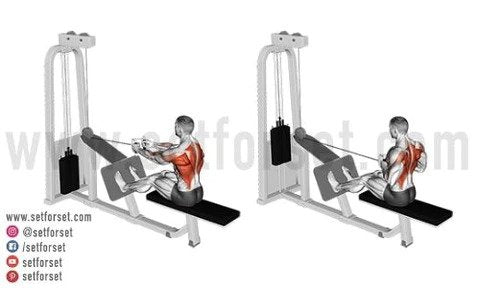
The seated row acts in the same way as the lat pulldown because since you’re sitting, many of the stabilizer muscles that normally activate are no longer required. For some variety, you can even swap attachments on a planned schedule.
If you’re following the at-home version, use your feet to push against the resistance, or find a low attachment point for your band.
How to do a Seated Row:
- Sit down with your feet shoulder-width apart, your knees slightly bent and placed firmly under the pad.
- Choose the straight bar for an overhand or underhand grip, or a handle when using a neutral grip. Consider alternating these different attachments and grips regularly.
- With your torso erect and arms straight to start, retract your shoulder blades.
- Tuck your elbows, driving them back. Slowly straighten your arms back to the starting position, and repeat.
10. Straight Arm Lat Pulldown:
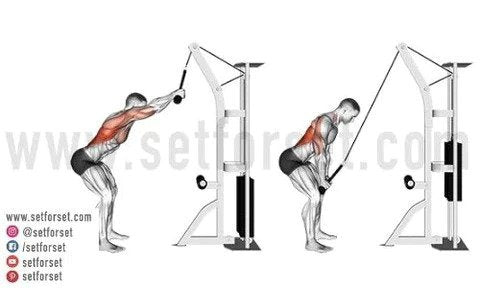
To perform straight-arm pulldowns, aka swimmers, you’ll use a straight bar, place your hands on the bar, and pull it down to your thighs. This is done through pure shoulder extension.
If you’re using a resistance band, attach the band to a high structure. Grab the band using a double overhand grip and adjust the width to use the right resistance. From here, follow the same movements.
How to do a Straight Arm Pulldown:
- Set up a cable at the highest setting and attach a straight bar.
- Stand a few feet back, grabbing the bar with an overhand grip
- Lean forward slightly, so your body is in line with the cable.
- Keeping your elbows slightly bent (just slightly!), pull the cable down to your hips.
- Think of making a big sweeping motion. Once it hits your thigh, slowly bring the cable back to the starting position.
4 Benefits of Strengthening Your Lats
Strengthening your lats will produce a plethora of positive results. Here are the 4 best reasons to train your lats.
1. Increases Upper Body Strength:
As the lats are such a massive upper body muscle, they play a role in every upper body movement, whether it’s as the primary agonist, antagonist, synergist, or stabilizing muscle. When you build your lats, you’re building your overall muscular strength.
2. Improves Your Pulling Performance:
While the lats will help with virtually every movement, its primary job is pulling. Pulling down at an angle, regardless of whether you’re using one arm or two, involves the lats.
It then makes sense that if you want to improve your pulling performance, you need to strengthen your lats. After all, even movements like deadlifts rely on the lats to maintain proper body control. If you want to pull heavy, strong lats are required.
3. Improves Spine Health:
Most people think of the erector spinae when it comes to spine health. Thinking in this way is accurate, as the erector spinae is the primary spine muscle.
However, the latissimus dorsi muscles also play a huge role in spine health. A portion of the lats originate on the spine, specifically the thoracic 7 vertebrae to lumbar 5, meaning the lats are attached to more than half of your spine!
Further, the lats control flexion and extension of the spine, so the stronger the lats are, the stronger your spine will be.
4. Enhances Your Aesthetics:
Wide shoulders and a V taper are the epitomai of male aesthetics. In order to get that V, you must have developed lats. And while the lats are trained with any pulling exercises, you must have specific lat exercises in order to make them pop.
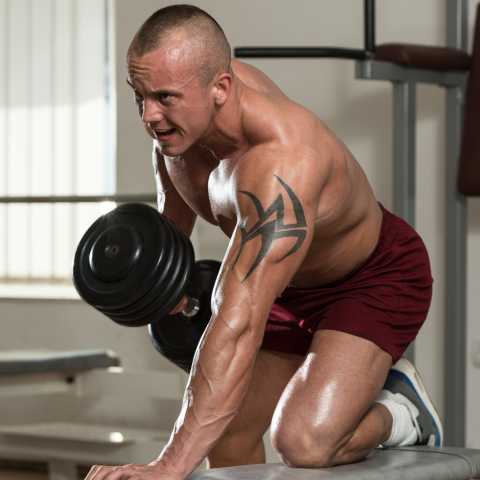
Tips to Help You Build Bigger Lats
Take your back workouts up a notch by following my favorite lat training tips and strategies.
- Really focus on your elbows, rather than the load, when performing your lats exercises. This mitigates the use of your biceps and places more stress on the lats.
- Pull the load as far as you can. I strongly believe that “the last few inches” of the movement are extremely important with your lat training.
- Focus on your lats and not your biceps and upper arm.
- Push yourself but choose an appropriate weight.
How To Continue Progressing Your Lat Training
One thing you need to remember when training your lats is that your progress will not be linear. At the same time, you must always strive to progress. This may seem a bit contradictory, but trust me, it’s not.
Here’s how you keep progressing.
1. Utilize Periodization:
Periodization is the term used to describe a method of altering the intensity and volume of a training workout as it progresses. Its primary purpose is to allow different physiological adaptations to rest at certain points in our training.
For example, you may focus on strength for a certain length of time and then switch to concentrating on hypertrophy. My programs generally always use a form of periodization known as daily undulating periodization (DUP), which is when we alter the intensity and volume of our workouts daily.
You can also utilize periodization on a grand scale, such as when you work with heavy singles for strength training or utilize maximal velocity training.
2. Swap Exercises:
I listed my top 10 exercises for lats, but there are so many different exercises you could potentially do. An easy way to give your muscles a slightly different stimulus is by swapping exercises.
For example, use a chest-supported rowing exercise instead of one of the rowing movements listed above. You can also use different attachments when performing cable machine exercises.
While we generally prefer free weights, the back does seem to respond well to machines such as hammer row, high row, or low row, so throw those into the mix too.
In fact, you can simply alter the width of your grip or switch between underhand and overhand grips for variation. The trick is to use movements with similar biomechanics. Do this every 4-6 weeks.
3. Use Recovery Or Deload Weeks When Necessary:
Finally, don’t forget to deload. As mentioned above, sometimes, we need to take a step back to continue moving forward.
This is one of the hardest lessons to learn as a new lifter (it’s even hard for advanced lifters sometimes), but you must learn it if you want to reach impressive heights.
During a deload week, consider doing some lat stretches to prevent things from getting overly tight.

Strong Lats Lead to Awesome Aesthetics
The lats are one of our favorite exercises to train. You can move a lot of weight during a lats workout, and I guarantee you’ll love how massive you feel after a good back pump. This is especially true once your lats start to protrude from your sides and your shirts begin to fit tight.
And when your arms lay outward due to necessity and not invisible lat syndrome, you’ll be glad you started to really focus on building your latissimus dorsi muscle.
























